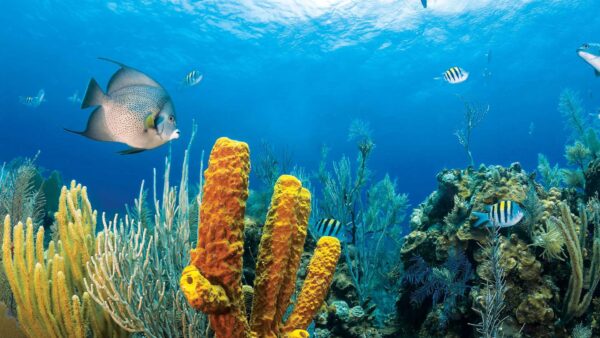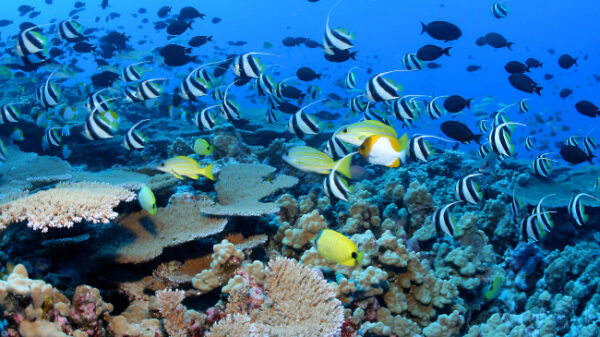Exploring the Enigmatic World of Marine Life
Covering more than 70% of Earth’s surface, the ocean is a vast, uncharted frontier brimming with life. From the sunlit shallows to the dark, mysterious depths, marine ecosystems host an incredible diversity of organisms. In this blog, we’ll explore the wonders of marine life, shedding light on the fascinating creatures and intricate ecosystems that thrive beneath the waves.
Coral Reefs: The Underwater Metropolises
Often likened to underwater rainforests, coral reefs are some of the most vibrant and diverse ecosystems on our planet. These intricate structures, built by tiny coral polyps, provide a home for a plethora of marine species. Fish, mollusks, crustaceans, and countless other organisms rely on coral reefs for shelter and sustenance.
Coral reefs are not only crucial for marine biodiversity but also protect coastlines from erosion and support local economies through tourism and fisheries. Unfortunately, these ecosystems are facing significant threats from climate change, pollution, and overfishing. Conservation and restoration efforts are vital to preserving these underwater treasures.
Ocean Giants: Whales and Dolphins
The open ocean is the domain of some of the largest and most intelligent animals on Earth: whales and dolphins. These magnificent creatures have long captivated human imagination with their beauty, intelligence, and complex behaviors.
Whales, such as the colossal blue whale and the acrobatic humpback whale, undertake long migrations across the world’s oceans. Their haunting songs, used for communication and mating, resonate through the water, creating a symphony of the sea.
Dolphins, known for their playful nature and remarkable intelligence, live in tight-knit social groups called pods. They navigate and hunt using echolocation, emitting sounds that bounce off objects and return as echoes, providing them with detailed information about their surroundings.
The Abyss: Life in the Deep Sea
Beyond the reach of sunlight lies the deep sea, an alien world of darkness and extreme conditions. Despite the cold, high pressure, and lack of light, life flourishes in this harsh environment.
Deep-sea organisms have evolved extraordinary adaptations to survive. The anglerfish, for instance, uses a bioluminescent lure to attract prey in the dark depths. Giant tube worms, found near hydrothermal vents, rely on chemosynthesis, where bacteria convert chemicals from the vents into energy.
Advancements in technology, such as submersibles and remotely operated vehicles (ROVs), have enabled scientists to explore these uncharted territories, uncovering new species and ecosystems and expanding our understanding of life on Earth.

The Delicate Equilibrium of Marine Ecosystems:
Marine ecosystems are intricate networks where every organism, from microscopic plankton to apex predators, plays a crucial role. This delicate balance is essential for the health of the ocean.
Human activities, however, are disrupting this balance. Overfishing, pollution, and climate change are taking a heavy toll on marine life. Plastic pollution, in particular, is a severe threat, with millions of tons entering the ocean annually, harming countless marine animals.
The Path to Marine Conservation:
Safeguarding our oceans and the diverse life they support is a global priority. Marine conservation efforts are gaining traction, with initiatives like marine protected areas (MPAs), sustainable fishing practices, and pollution reduction strategies making significant progress.
Innovative solutions, such as biodegradable plastics and improved waste management, are being developed to tackle ocean pollution. Public awareness and education campaigns are also essential in fostering a deeper connection to the ocean and motivating conservation efforts.
Conclusion:
The ocean, a realm of wonder and mystery, is home to an astonishing variety of life forms. From the bustling coral reefs to the enigmatic depths of the deep sea, marine life continues to inspire awe and curiosity. By understanding and protecting this vital part of our planet, we can ensure that future generations will also be able to marvel at the ocean’s beauty and diversity.
Together, we can make a difference in preserving the health of our oceans and the incredible creatures that inhabit them. Let us commit to safeguarding the future of marine life for generations to come.
FAQs:
1. What is marine life?
Marine life encompasses all the living organisms found in saltwater environments, from tiny microorganisms like plankton to gigantic mammals like whales. This diverse group includes fish, corals, mollusks, crustaceans, marine plants, and many more species that thrive in the ocean and other saltwater bodies.
2. Why is marine life vital?
Marine life is essential for various reasons:
- Biodiversity: Oceans house an immense variety of species, many of which are still undiscovered.
- Ecosystem Services: Marine organisms help maintain climate balance, produce a significant portion of the Earth’s oxygen, and provide sustenance and economic benefits to humans.
- Medical Research: Many marine species have unique biochemical properties that are valuable for developing new medicines and treatments.
3. How does climate change impact marine life?
Climate change affects marine life in several significant ways:
- Rising Temperatures: Increased ocean temperatures can lead to coral bleaching and alter species distribution.
- Ocean Acidification: Higher levels of CO2 decrease the pH of seawater, harming shell-forming organisms such as corals and mollusks.
- Sea Level Rise: Higher sea levels can destroy coastal habitats and disrupt marine ecosystems.
4. What are coral reefs and their importance?
Coral reefs are complex underwater structures created by the calcium carbonate skeletons of corals. They are vital because:
- Biodiversity Hotspots: They support a wide array of marine species.
- Coastal Protection: They shield shorelines from erosion and storm damage.
- Economic Benefits: They generate income through tourism and fisheries.
5. What is overfishing and why is it problematic?
Overfishing happens when fish are caught at a faster rate than they can reproduce. This is problematic because:
- Depletion of Fish Stocks: It can lead to the collapse of fish populations.
- Disruption of Ecosystems: Removing large numbers of fish disrupts food webs and harms other marine life.
- Economic Consequences: It negatively impacts communities reliant on fishing for their livelihoods.
6. How can I contribute to marine life conservation?
You can help protect marine life by:
- Reducing Plastic Use: Limit plastic consumption and ensure proper disposal of plastic waste.
- Choosing Sustainable Seafood: Opt for seafood harvested through sustainable practices.
- Lowering Carbon Footprint: Use energy-efficient appliances and reduce reliance on fossil fuels.
- Participating in Cleanups: Join or organize beach and waterway cleanups.
- Supporting Conservation Organizations: Donate to or volunteer with groups dedicated to marine conservation.
7. What are marine protected areas (MPAs)?
Marine Protected Areas (MPAs) are sections of the ocean where human activities are more strictly regulated to protect natural or cultural resources. They help preserve biodiversity, protect endangered species, and maintain healthy marine ecosystems.
8. What unique adaptations do deep-sea creatures have?
Deep-sea organisms have evolved remarkable adaptations to survive extreme conditions, such as:
- Bioluminescence: The ability to produce light to attract prey or communicate.
- Pressure Tolerance: Adaptations that allow them to withstand immense pressure.
- Slow Metabolism: To conserve energy in an environment with limited food sources.
9. How do marine organisms affect the global carbon cycle?
Marine organisms play a crucial role in the carbon cycle:
- Phytoplankton: These tiny plants absorb CO2 during photosynthesis and produce oxygen.
- Carbon Storage: Marine plants and animals sequester carbon in their bodies, and when they die, this carbon can become stored in ocean sediments.
10.What is ocean acidification and what causes it?
Ocean acidification is a phenomenon where the ocean’s pH decreases due to the absorption of excessive carbon dioxide (CO2) from the atmosphere. This absorption leads to a chemical reaction that increases the acidity of seawater, posing significant threats to marine ecosystems.




